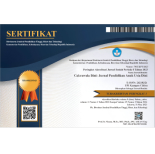The Effectiveness of Disability Picture Storybooks for Children 5-6 Years Old in Inclusive Kindergarten
Abstract
Keywords
Full Text:
PDFReferences
Agustina, R., Sari, O. L., Sholihah, L. A., Rizqi, N., Octavia, L., Pramesthi, I. L., Prafiantini, E., and Kardha, P. C. D. (2018). Development of innovative picture storybooks to empower parents and teachers for early childhood education in nutrition and social-behavior in Jakarta. ASEAN Journal of Community Engagement, 2(2), 298-315.
Bhana, N., McNaughton, D., Raulston, T., and Ousley, C. (2020). Supporting communication and participation in shared storybook reading using visual scene displays. Teaching Exceptional Children, 52(6), 382-391.
De Boer, A., Pijl, S. J., Minnaert, A., and Post, W. (2014). Evaluating the effectiveness of an intervention program to influence attitudes of students towards peers with disabilities. Journal of Autism and Developmental Disorders, 44, 572-583.
Diamond, L. L., and Hsiao, Y. J. (2019). Picture-Based situation cards to support problem-solving skill development for young children with disabilities. Teaching Exceptional Children, 52(2), 107-115.
Fang, Z. (1996). Illustrations, text, and the child reader: What are pictures in children's storybooks for?. Reading Horizons: A Journal of Literacy and Language Arts, 37(2), 130-142.
Golos, D. B., and Moses, A. M. (2013). Rethinking the portrayal of deaf characters in children's picture books. Frontiers in Psychology, 4, (889), 1-3
Jaswandi, L. N., and Kurniawati, F. (2019, August). Acceptance of children with special needs in early childhood inclusive education programs. In 2nd International Conference on Intervention and Applied Psychology (ICIAP 2018). Atlantis Press, 610-618.
Malu, K. F. (2013). Exploring children's picture storybooks with adult and adolescent EFL learners. In English Teaching Forum US Department of State. Bureau of Educational and Cultural Affairs, Office of English Language Programs, SA-5, 2200 C Street NW 4th Floor, Washington, DC 20037, 51(3), 10-18.
McGee, L. M., and Schickedanz, J. A. (2007). Repeated interactive read‐alouds in preschool and kindergarten. The Reading Teacher, 60(8), 742-751.
Morrow, L. M., and Smith, J. K. (1990). The effects of group size on interactive storybook reading. Reading Research Quarterly, 25(3)213-231.
Murphy, K. A., Pentimonti, J. M., and Chow, PhD, J. C. (2023). Supporting children’s language and literacy through collaborative shared book reading. Intervention in School and Clinic, 58(3), 155-163.
Nasatir, D., and Horn, E. (2003). Addressing disability as a part of diversity: Through classroom children's literature. Young Exceptional Children, 6(4), 2-10.
Ostrosky, M. M., Mouzourou, C., Dorsey, E. A., Favazza, P. C., and Leboeuf, L. M. (2015). Pick a book, any book: Using children’s books to support positive attitudes toward peers with disabilities. Young Exceptional Children, 18(1), 30-43.
Trussell, J. W., Dunagan, J., Kane, J., and Cascioli, T. (2017). The effects of interactive storybook reading with preschoolers who are deaf and hard-of-hearing. Topics in Early Childhood Special Education, 37(3), 147-163.
Walsh, R., Bowes, J., and Sweller, N. (2017). Why would you say goodnight to the moon? Response of young intellectually gifted children to lower and higher order questions during storybook reading. Journal for the Education of the Gifted, 40(3), 220-246.
Wicks, R., Paynter, J., and Westerveld, M. F. (2020). Looking or talking: Visual attention and verbal engagement during shared book reading of preschool children on the autism spectrum. Autism, in SageJournals 24(6), 1384-1399.
Wright, B. M., Benigno, J. P., Boster, J. B., McCarthy, J. W., and Coologhan, B. K. (2020). “Tell me about your picture”: Using drawings to support expressive language in children with autism spectrum disorder. Communication Disorders Quarterly, 42(1), 3-11.
DOI: https://doi.org/10.17509/cd.v14i2.61013
Refbacks
- There are currently no refbacks.
Copyright (c) 2023 UPI Kampus Cibiru

This work is licensed under a Creative Commons Attribution-ShareAlike 4.0 International License.
Cakrawala Dini: Jurnal Pendidikan Anak Usia Dini
Published in collaboration Program Studi PGPAUD UPI Kampus Cibiru, APG PAUD Indonesia, and PPJ PAUD Indonesia

Cakrawala Dini: Jurnal Pendidikan Anak Usia Dini is licensed under a Creative Commons Attribution-ShareAlike 4.0 International License.
Based on a work at https://ejournal.upi.edu/index.php/cakrawaladini.














